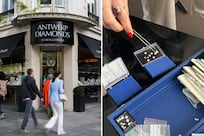Anyone going to see a Star Trek movie expects a spectacular vision of the 23rd century, and the latest incarnation – which opened in the UAE last week – does not disappoint.
Amid all the breath-taking vistas, impacts and explosions, it is almost comforting to see such “familiar” technology as phasers, transporters and warp drives.
Dreamt up half a century ago by the creative genius behind the original series, Gene Roddenberry, much of the technology of Star Trek has already become a reality.
No one thinks twice about flipping open a “communicator” and talking instantly with someone thousands of miles away. Add in the right apps plus a decent data link, and you’ve got yourself a tricorder and all-knowing computer.
The generation of scientists who watched the series as kids are now making its even more mind-boggling technology a reality.
Over the past few years, they have unveiled ever more impressive versions of the "cloaking" technology, used by the perfidious Romulans to hide their attack ships in early episodes of Star Trek.
Early versions could only shield small objects from detection, using bulky “meta-materials” to bend microwave radiation around the object, thus rendering it invisible to radar at least.
But a team at the University of Texas, Austin, has announced the creation of an ultra-thin copper-and-plastic cloak that can not only shield objects from microwaves, but may even do the same for visible light.
Meanwhile, researchers at the University of St Andrews in Scotland have unveiled the world’s first “tractor beam”, the Star Trek version of the tow-rope, two centuries ahead of time.
In the series, the tractor beam was able to pull objects towards it. So far, the 21st century equivalent can only pull microscopic objects, using specially shaped laser beams. Still, it’s a start.
But of all the Star Trek staples, no technology is more sought-after yet elusive than the warp drive.
Without it the possibility of leaving the solar system, let alone on five-year missions to strange new worlds, will remain a distant dream.
The problem, of course, is that the warp drive defies that most famous prohibitions in physics – the ban on faster-than-light travel.
Usually invoked along with the name of Albert Einstein, the ban has its origins in his special theory of relativity – which, as its name suggests, applies only in specific circumstances.
The good news for wannabe Captain Kirks is that Einstein’s general theory of relativity has no such prohibition. The bad news is that exploiting that freedom involves challenges that would give even the chief engineer, Scotty, a headache.
Yet according to recent reports, the US space agency Nasa has decided to have a go. A team at the agency’s Eagleworks Laboratory in Houston, Texas, is said to be working on a real-life means of faster-than-light travel, based on a concept uncannily like that used by the USS Enterprise.
It had its origins in work published almost 20 years ago by a theoretical physicist, Miguel Alcubierre, at Cardiff University in Wales.
In 1994, Dr Alcubierre made headlines worldwide by suggesting that one way to go faster than light was to alter the fabric of space and time itself. To see how it works, imagine space as a huge tablecloth. The usual way of getting from A to B is simply to travel across that cosmic tablecloth until you reach your destination.
But there is another way – stay where you are and wrinkle up the tablecloth until your destination comes to you.
Dr Alcubierre showed that Einstein’s theory allows space to be distorted like this. Better still, anything connected to the “warp engine” that triggers the effect would effectively travel through space faster than the speed of light.
But there is a catch. To induce that kind of warping, huge amounts of a weird form of so-called vacuum energy would be needed. And no one knew how to create it.
Now, however, this seemingly insuperable barrier is being attacked by a team at Eagleworks, led by Dr Harold White.
While preparing to give a talk on the challenges of faster-than-light travel at a conference last October, Dr White saw a way around the energy problem.
Dr Alcubierre had envisaged curving the fabric of spacetime using a ribbon-like region of vacuum energy. But according to Dr White, a thicker, doughnut-shaped region would achieve the same effect much more efficiently.
Rough calculations suggest the amount of vacuum energy needed could be cut from something equivalent to the mass of Jupiter – about 2 trillion trillion tonnes – to about the mass of a family car.
While an impressive achievement, it still leaves untouched the problem of creating even that amount of vacuum energy.
On the face of it, it should not be that difficult. Our universe is replete with the stuff, in the form of what astronomers call Dark Energy, whose weird anti-gravity effect propels the expansion of the cosmos.
Vacuum energy has also been glimpsed in the laboratory, in the form of the so-called Casimir Effect, which forces two conducting plates together when brought into close proximity.
The trouble is that in both cases the vacuum energy is incredibly dilute. Dr White and his colleagues have to find a way of concentrating the stuff and then moulding it into the desired shape to curve space and time.
Engineers have triumphed in the face of barely less demanding challenges. Back in 1865, the Scottish physicist James Clerk Maxwell – one of Einstein’s heroes – predicted the existence of bizarre force-fields called “electromagnetic waves”.
It took another 20 years to confirm their existence, and 20 more to use them in communication. Now engineers can send them to probes at the edge of our solar system and receive them from the ends of the cosmos.
Dr White and his team are starting on a modest scale, searching for ways of warping spacetime on atomic scales, and working up from there. You can almost hear chief engineer Scott, across the centuries, cheering them on.
Robert Matthews is visiting reader in science at Aston University, Birmingham, England





